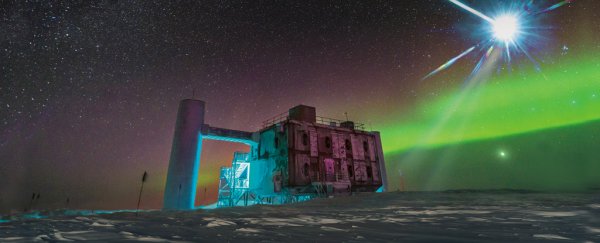When physicists detected signals of high-energy neutrinos coming from a rather unlikely direction in the cosmos, they naturally went looking for a powerful source that might explain it.
An intense examination of the most likely origins of these more reactive forms of 'ghost' particles has now come up empty-handed, opening the way for more exotic speculations over what might be behind the odd signals.
Trawling through seven years of data from the neutrino-hunting IceCube experiment, a large team of researchers from around the globe are now forced to admit conventional explanations for the discovery are looking pretty weak.
Neutrinos are electron-like members of the Standard Model of fundamental particles. Unlike electrons, they have insanely small masses and no charge.
This slim-bodied neutrality means neutrinos don't care to stop and chat with other particles. Atomic decay deep inside the Sun sends torrents of them through the planet every second, with only a fraction passing close enough to an atom to cause a noticeable response.
To catch the rare flash of a neutrino smashing into a frozen water molecule, the IceCube observatory uses long strings of sensitive light-capturing equipment buried under Antarctic ice.
For nearly a decade, it has been recording hundreds of flashes per day, building a vast database of information on the directions and energies of neutrinos washing over Earth.
But it's not the only game in town. From an altitude of nearly 40 kilometres above the Antarctic, suspended from a helium balloon, NASA's Antarctic Impulsive Transient Antenna (ANITA) captures hints of neutrinos with ridiculously high energies smashing into atoms in the atmosphere.
It's still early days for ANITA, but already its first few flights over the past couple of years have successfully spotted several tell-tale flashes of the energetic particles. Strangely, two of the signals have come not from the empty sky above, but up through the planet itself.
For a lazy neutrino fresh from the Sun, this wouldn't be all that surprising. But at the kinds of energies recorded by ANITA, neutrinos become real socialites, merging with our planet's atoms at a much higher rate to leave very few untouched.
"It's commonly said that neutrinos are 'elusive' or 'ghostly' particles because of their remarkable ability to pass through material without smashing into something," says astrophysicist Alex Pizzuto from the University of Wisconsin–Madison in the US.
"But at these incredible energies, neutrinos are like bulls in a china shop – they become much more likely to interact with particles in Earth."
Finding a couple of 'bullish' neutrinos making it all the way through the planet demands some kind of explanation.
Of course, they could just be chance discoveries of incredibly rare examples. Being so lucky isn't out of the question. But it's far more likely that the particles detected had struck the planet as part of a massive crowd.
High-energy neutrinos tend to be born in interactions between cosmic rays and atomic nuclei, before being given a hard push by strong magnetic fields deep out in the cosmos.
Because of this, the researchers worked out the statistics on how many high-energy neutrinos it would take to have a good chance of ANITA spotting them, and dug through IceCube's data to find potential events that could be responsible for making them in high numbers.
"This process makes IceCube a remarkable tool to follow up the ANITA observations, because for each anomalous event that ANITA detects, IceCube should have detected many, many more," says physicist Anastasia Barbano of the University of Geneva in Switzerland.
"Which, in these cases, we didn't."
So, where to now then?
First off, it's worth keeping in mind that even the most well-funded, professional experiments can be susceptible to errors.
Less than a decade ago, there was a flurry of excitement over the possibility of finding neutrinos moving faster than light … a finding that was tested at length, before being found to be more than likely a mistake.
The new findings are currently available on the pre-print site arXiv.org, with a submission underway to The Astrophysical Journal, where the results will receive greater scrutiny from the scientific community.
But there are a few tantalising possibilities we can consider even now, and even dare to imagine explanations outside of established physics.
"Our analysis ruled out the only remaining Standard Model astrophysical explanation of the anomalous ANITA events," says Pizzuto.
"So now, if these events are real and not just due to oddities in the detector, then they could be pointing to physics beyond the Standard Model."
One possibility is cosmic accelerators pumping out bursts of neutrinos at time scales too brief for scientists to catch with current technology.
If we want to really get wild, we might even consider a role for dark matter, or imagine new kinds of particles that act like high-energy neutrinos but are produced in other ways.
There's a lot of room for questions, and right now our search for neutrino secrets is still in its infancy. With so much to learn, a lot of hope is being pinned on neutrinos providing insight into big mysteries that could lead the way to new physics.
IceCube and ANITA will no doubt be looking out for more of these puzzling high-energy 'ghosts', in the hope of pushing the limits on physics.
The pre-print paper is available at arXiv.org.
